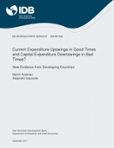Current Expenditure Upswings in Good Times and Capital Expenditure Downswings in Bad Times?: New Evidence from Developing Countries
Date
Oct 2017
This paper studies the cyclical properties of two key expenditure categories (current and public investment spending) during the different phases of the business cycle (good times and bad times). Anecdotal evidence suggests that policymakers usually cannot resist the temptation of spending more on current expenditure in good times, but only pick capital expenditures to adjust during bad times. The paper answers the following questions: do current and capital expenditures react to the business cycle? If so, by how much, and why? In a sample of more than 100 developing countries and 30 developed countries observed between 1980 and 2014, a new empirical regularity specific to developing countries is identified: upswings are associated with increases in current primary expenditures (e.g., wages, transfers) only, while public investment falls and current spending remains acyclical during downturns. Evidence is also presented that this asymmetrical response is more pronounced in countries where incumbent politicians face shorter time horizons and weak institutions. Other type of factors traditionally discussed in the literature (limited creditworthiness, fiscal rules, and tax base volatility) have limited explanatory power.



